| |
|
St
Bartholomew, Norwich
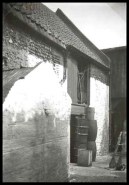 |
|
Conesford
was the long, straggly suburb to the south of the
medieval city, within the walls but with an
independent life of its own. Conesford had nine
medieval parish churches, as well as several
monasteries, and was home to important merchants
- the Pastons' Norwich house was in Conesford,
down on the main road to London, the Royal
Conesford way. Today, this is King Street.
Parallel to it, but high on the ridge to the
west, is Ber Street, leading out of the city
centre to the Berstrete Gate in the city walls. In the 18th
and 19th centuries, this part of Norwich became
home to warehouses and factories, a slum area of
workshops and back to back terraces. As if to
prefigure this, St Bartholomew was abandoned in
the 16th century, and became used as a factory.
Gradually, other buildings were built on to it,
until almost nothing at all of the medieval
exterior showed. You would not even have known it
was there - all that was visible was part of the
south wall of the nave, shown here on the left in
George Plunkett's 1930s photograph.
|
About this
time, George sketched in his own hand Claude Messent's
plan of the building as it was in 1931. You can see this
sketch at the bottom of the page. 19th century houses had
been built into the west end. The nave and chancel were
part of Snellings factory. Against the north wall was a
slaughterhouse.
George
Plunkett's fascination with the Norwich churches led him
to be at hand when the Norwich City Corporation began to
clear the site in the summer of 1939. If they had left it
a couple of years then they needn't have bothered; the
Luftwaffe would have done it for them. As it was, the
ramshackle lean-to buildings were peeled away and the
core of a medieval church revealed; the blocked up
chancel arch, Tudor arched interior window splays, a
brick south doorway.
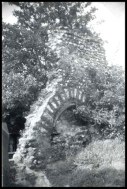 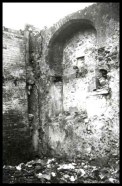 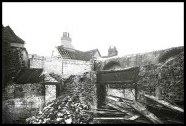 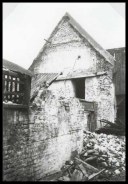
All this has now gone, and all that survives
is the stump of the tower beside the pavement on Ber
Street. It is usually supposed to be a victim of war
damage, like St Michael at Thorn a hundred metres to the
north, but this is not the case. Modern sheltered housing
sits on the place where the church and the factory and
the slaughterhouse was.
St Bartholomew should not be confused with
Norwich's other medieval church of the same name. The
other one was the parish church for Heigham, the area to
the west of Pottergate and St Benedict, and is also a
ruin today - but unlike the long-suffering St Bartholomew
of Ber Street, the Heigham church really was gutted in
the blitz.
Simon Knott, December 2005
|
|
|
